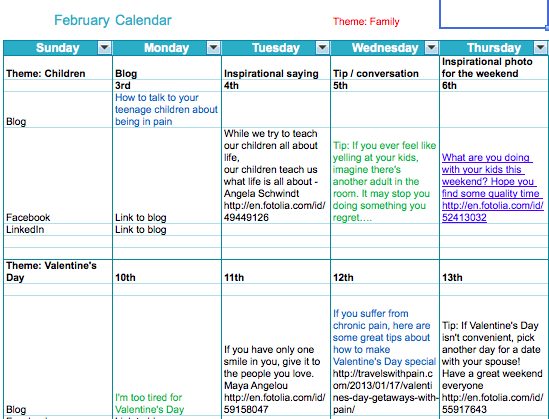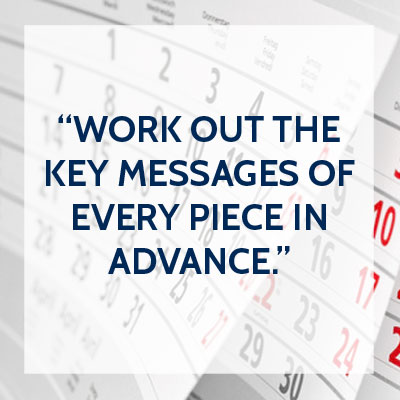
It’s nearing the end of the day and you suddenly remember that you still haven’t got round to the blog post you intended to write. To cross this one lingering item off your to-do list, you sit down, dash off a few paragraphs and post it to your company’s blog and social media feeds.
“It doesn’t hit all the right notes, but it’ll have to do,” you think, promising yourself that next time you will plan ahead.
Does this scenario sound familiar?
Quite often a company’s content strategy can become an afterthought, rather than a strategically driven part of its marketing platform.
Setting up an editorial calendar ensures that your content is well thought-out in advance, so that everything you produce is in line with, and advances, your company’s strategy. It also reduces stress, because you don’t have to scramble around for content ideas at the last minute, and ensures that there are no gaps in your publication schedule.
1. Getting started
An editorial calendar can be anything from an Excel spreadsheet or a shared Google calendar to a custom-designed template. A quick search on Google will turn up a plethora of resources, including many templates that you can download free of charge. Many marketing automation tools (that you have to pay for) also integrate editorial calendars into their programmes.
You can plan as far ahead as a year, but three to six months in advance may be a more reasonable starting point. Most importantly, build some flexibility into the calendar so you can easily respond to current or unexpected events, and remember to build in time to re-post third-party material that will always make up a large portion of your content programme.
No matter what type of calendar you decide to use, make sure that all members of your team can easily access it, so that everyone knows what’s coming. Think carefully who can amend it – your editorial calendar needs to be an essential part of your team’s process but at the same time, too many cooks can spoil the broth….
2. What to include
The more detailed you can make each calendar entry the better. Thorough planning will give the writer ideas to mull over before they begin and will help them more easily research and write the piece.
Details that you can incorporate on your calendar include:
- The date and time the piece will go up.
- Type of content – Compelling content isn’t limited to blog posts or articles. You can also put out infographics, photos, newsletters and social media updates.
- Name of the piece – There’s no better way to guarantee reader engagement than with a catchy headline so start thinking of this early on.
- Description – What exactly will this piece be about?
- Key messages – Outlining this for each piece will focus your writers and ensure that your content advances your communications strategy.
- Target audience – Who is it intended for? Ensure that you produce a range of content to appeal to all your potential audience groups, wherever they are in the buying cycle (eg. Very early on in the process / just about to buy / existing customer) – their needs will be different!
- Pictures – Plan visuals way ahead of publication time.
- Hashtags – Think in advance how you’re going to promote your piece.
- Writer – Who is responsible for the piece and what’s the internal deadline?
- Post-mortem – What was the reaction to the piece? Include retweets, likes and shares. By measuring past success you can better plan for the future.
- Space for general notes – This can be used as a brainstorming tool as well as a to-do list.
3. Organise your content
Before populating your editorial calendar, you need to carefully work out what kind of content you want to produce. Think carefully about your content strategy – and preferably put it into writing: What do you want your content to accomplish? Who are you going to target? How is your content going to get them engaged, and push them towards a sale?
Once you have a clear content strategy in place, you can work out what you’re going to put on your calendar.
 Ways to organise your content include:
Ways to organise your content include:
- Giving each month a theme (and even sub-themes). This will allow you to explore issues in your industry in greater detail.
- Assigning different types of content to days of the week. For example, you could plan to post guest contributions on Mondays, email updates on Tuesdays and photo posts on Wednesdays. You could write a blog post for a certain group on one day, and for another group later in the week.
- Look through your calendar and identify events, holidays and other goings-on that you can write about or use as a jumping off point. Christmas may be obvious, but you can also plan to include industry events or new services your company plans to introduce.
With so many different ways to organise your content, it’s worth exploring several options to find the best fit for your company.
4. Cut your workload
No one likes to do more work than needed. Take a look through your company’s existing written materials and content offerings to see if you can reuse or repurpose them for use on several platforms. Perhaps an industry update can be made into an infographic, a news release can be shortened for a Facebook post or a point you made in an article can be expanded into a longer length feature.
Use your editorial calendar to make sure that you are not spreading your team too thin. Keep a realistic view of how much content they can produce. Being over-ambitious is a quick route to ensuring that the entire plan is abandoned.
Perhaps the most satisfying part of using an editorial calendar comes when you finish your piece and can mark it as complete!
What features do you find essential on your editorial calendar? Share your planning tips below.







